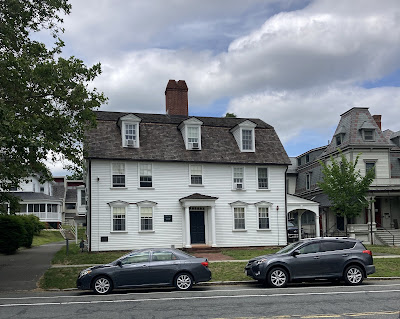Sorry Northampton (and Smith College) - "[Not] The Site Of Clandestine Visits"
British prisoners noted likewise. Lieutenant (Lord) Francis Napier of the 31st Regiment of Foot wrote in his Journal: "October ... 27th. [Marched from Chesterfield, Massachusetts to] Northampton 12 m[iles]" and "... 28 Halt". [4] The anonymous keeper of a journal associated with the 47th Regiment of Foot, with the remainder of the British column, two days behind, would record: "Oct 30 [stopped at] North hampton miles [marched] 11” [5]
Northampton is a fun place to visit. My own earlier visits were to what I'd call "downtown", that area along Main Street (Route 9) between Elm Street to the west and Route 5 to the east. That section of town offers easy walking to a wide variety of stores, shops, restaurants and bars. Just east of Route 5, at 56 Bridge Street, is the museum and education center of Historic Northampton - still on my "to-do" list of places to explore. On my most recent visit we explored the campus of Smith College. The college's Museum of Art is open to the public and free to all, as are the Lyman Plant House and the outside gardens.
One college building was there when the Convention Army passed. (It's not the Helen Hills Hills Chapel seen above, despite its appearance. That was built in 1955, not in the late 18th or early 19th century.) What is now Sessions House, a dormitory for Smith College, was the home built in 1710 by Captain Jonathan Hunt. According to the college's website "... the most popular house legend is that the staircase was the site of clandestine visits between Captain Hunt's granddaughter Lucy and Johnny Burgoyne, a British Redcoat held captive in the house during the Revolutionary War."
Is there evidence to suggest that "Johnny" Burgoyne stayed in the Hunt's home (or his ghost still haunts it)? I've seen none to date, and don't expect to. Burgoyne doesn't appear to have ever traveled through Northampton, never mind had a rendezvous with a local lass - or to have gone through Hadley, on the east bank of the Connecticut River, but that's another story, for next week. While Northampton was a major crossing point on the river, and served as such for the British column, Burgoyne crossed twenty miles to the south, from West Springfield into Springfield.
Is there evidence to suggest Burgoyne's ghost haunts any New England home? An observation by Abagail Adams suggests that if his spirit doesn't, the memory of him may have for a while. Regarding his stay in Boston, she wrote from her home in Braintree to her husband John on July 25, 1775: “General Burgoyne lives in mr. Samll. Quincys House. a Lady who lived opposite Says she Saw raw meat cut & hacked upon her Mahogona Tables, & her Superb Damask curtain & cushings exposed to the rain as if they were of no value… As to Burgoyne I am not Master of Language sufficient to give you a true Idea of the Horrible wickedness of the Man. His designs are dark, His Dissimulation of the deepest die, for not content with deceiving Mankind he practices deceit on God himself, by Assuming the Appearance (like Hutchinson) of great attention to Religious Worship when every action of his life is totally abhorant to all Ideas of true Religion, Virtue or common Honesty. An Abandoned Infamous Gambler of Broken fortune and the Worst Most detestable of the Bedford Gang who are wholly bent on Blood, tyrany and Spoil...” [6]
For more on the Convention Army's 1777 march from Saratoga to Boston, see:





Comments
Post a Comment